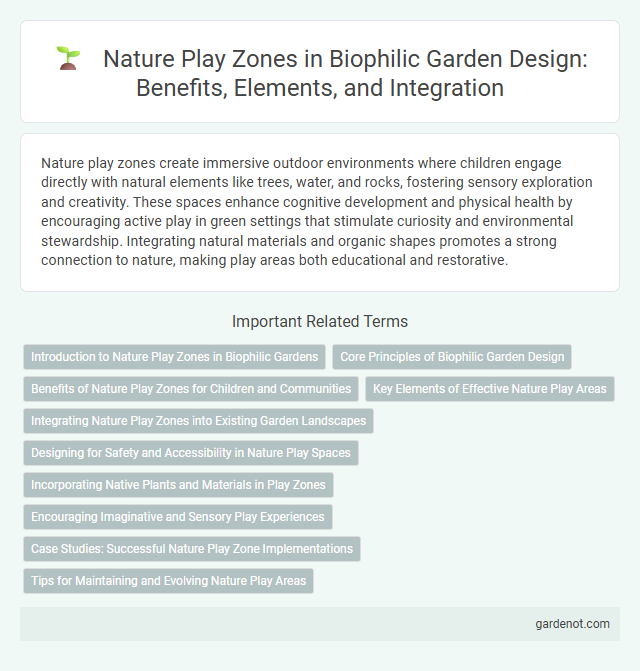Nature play zones create immersive outdoor environments where children engage directly with natural elements like trees, water, and rocks, fostering sensory exploration and creativity. These spaces enhance cognitive development and physical health by encouraging active play in green settings that stimulate curiosity and environmental stewardship. Integrating natural materials and organic shapes promotes a strong connection to nature, making play areas both educational and restorative.
Introduction to Nature Play Zones in Biophilic Gardens
Nature play zones in biophilic gardens create immersive natural environments where children engage with organic elements like plants, stones, and water features to stimulate sensory and motor development. These zones emphasize unstructured play that fosters creativity, environmental stewardship, and physical health through direct interaction with biodiversity. Integrating native vegetation and natural materials enhances ecological connectivity and supports sustainable urban biodiversity within built environments.
Core Principles of Biophilic Garden Design
Nature play zones embody the core principles of biophilic garden design by integrating natural elements such as native plants, water features, and varied terrains to promote sensory engagement and physical activity. These spaces emphasize direct interaction with the environment, fostering emotional connections and enhancing well-being through immersive experiences with natural textures, sounds, and forms. Incorporating fractal patterns, natural materials, and diverse biodiversity supports cognitive restoration and creativity in children and adults alike.
Benefits of Nature Play Zones for Children and Communities
Nature play zones enhance children's cognitive development, creativity, and physical health by providing immersive outdoor environments that stimulate sensory experiences and motor skills. These natural spaces foster social interaction, community cohesion, and environmental stewardship among residents, promoting mental well-being and resilience. Integrating biophilic design principles in urban planning creates accessible nature play areas that support sustainable ecosystems and enrich community life.
Key Elements of Effective Nature Play Areas
Effective nature play areas incorporate diverse natural materials like wood, water, and plants to stimulate sensory exploration and creativity. Varied terrain features such as hills, logs, and rocks provide physical challenges that promote motor skill development and risk assessment. Inclusion of wildlife habitats and interactive water elements fosters environmental awareness and encourages imaginative, unstructured play.
Integrating Nature Play Zones into Existing Garden Landscapes
Integrating nature play zones into existing garden landscapes enhances children's creativity and physical development by incorporating natural elements such as logs, boulders, and native plants. These zones promote sensory engagement and encourage exploration, fostering a deeper connection to the environment. Thoughtful placement ensures harmony with the overall garden design, supporting biodiversity and sustainability within the play area.
Designing for Safety and Accessibility in Nature Play Spaces
Designing nature play zones prioritizes safety by incorporating non-toxic, durable materials and rounded edges to prevent injuries while maintaining natural aesthetics. Accessibility is enhanced through smooth, level pathways and sensory-rich elements that accommodate children with diverse abilities, fostering inclusive play. Integrating clear sightlines for caregivers and shaded resting areas further ensures a secure and welcoming environment for all users.
Incorporating Native Plants and Materials in Play Zones
Incorporating native plants and materials in nature play zones enhances ecological connectivity and supports local biodiversity. Using indigenous trees, shrubs, and natural elements like stone and wood creates immersive, sensory-rich environments that foster children's environmental awareness. These authentic materials promote sustainable play spaces by reducing maintenance needs and supporting native wildlife habitats.
Encouraging Imaginative and Sensory Play Experiences
Nature play zones encourage imaginative and sensory play experiences by incorporating natural elements such as logs, water features, and native plants that stimulate creativity and exploration. These environments engage multiple senses, promoting tactile, auditory, and visual interactions essential for cognitive and emotional development. Integrating natural materials enhances children's connection to the environment while fostering problem-solving and social skills through unstructured play.
Case Studies: Successful Nature Play Zone Implementations
Case studies of successful nature play zone implementations highlight projects like the Children's Museum of Houston, where natural elements such as water features, boulders, and native plants create immersive outdoor learning environments that boost children's creativity and physical activity. In New Zealand, the Te Whanau a Apanui Children's Forest integrates indigenous flora and cultural storytelling, fostering environmental stewardship and connection to place among young visitors. These examples demonstrate how carefully designed nature play zones promote cognitive development, ecological awareness, and community engagement through hands-on interaction with natural landscapes.
Tips for Maintaining and Evolving Nature Play Areas
Regular inspection of natural materials and plant health ensures a safe and vibrant nature play zone, promoting continuous engagement. Incorporating diverse native species encourages ecological balance and stimulates sensory exploration for children. Periodic redesign based on user interaction and seasonal changes keeps the play area dynamic and educational.
Nature play zone Infographic

 gardenot.com
gardenot.com